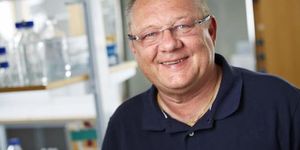As a patient prepares to become the first in history to receive his own genetically engineered stem cells for sickle cell disease, two top scientists are already improving the approach.
The team of University of California, Los Angeles (UCLA) immunologist Donald Kohn will soon be adding a healthy version of the hemoglobin, beta (HBB) gene, mutated in sickle cell, to blood stem cells his team will have taken from a patient's bone marrow, according to KohnThen his team will give the corrected stem cells back. Kohn's team is confident, given that the same approach-adding a gene to cells with one gene mutation-has been succeeding in two of Kohn's (also pioneering) adenosine deaminase-severe combined immunodeficiency (ADA-SCID) gene therapy trials.
Meanwhile, both he and hematologist Linzhau Cheng of Johns Hopkins University published papers this month that went further, correcting the mutation in sickle cell blood cells.
"Both studies for developing next-generation gene correction of sickle cell disease are worthy," Cheng told Drug Discovery & Development. "These are significant steps forward from the previous gene therapy strategies: using viral vectors to add a copy of genes into hematopoietic stem and progenitor cells."
Gene therapy and ADA-SCID
Kohn's team reported on two clinical trials, in which they gave a healthy ADA gene to patients with ADA-SCID, at the end of February at the American Society for Blood and Marrow Transplantation meeting. In a Phase 2 study, patients aged three months to 15 years were given their own blood stem cells back after a healthy version of the ADA gene was introduced to their cells via a retroviral vector (a defanged virus). As a result of that 2009 to 2014 trial, nine of ten patients are still off enzyme replacement therapy, and three were able to discontinue intravenous immunoglobulin (IVIg). (The tenth patient was the oldest, which may be relevant.)
In May 2013, Kohn started a new ADA gene therapy trial, this time using a next-gen technology, a self-inactivating lentiviral vector considered safer. Eight patients, aged four to 42 months old, have been enrolled. The six who are more than 30 days out are all off enzyme replacement therapy.
No vectors have caused tumorous off-target mutations.
UCLA immunologist Donald Kohn, M.D.
"We hope to complete a paper on the retroviral vector trial by the end of summer," Kohn told Drug Discovery & Development. "We are doing sample analyses now-vector copies/cell, vector integration sites, TREC, IL-7 levels, and others."
A similar approach will be at work in Kohn's newest clinical trial. He will add a healthy version of the gene that mutates in sickle cell disease-using a self-inactivating lentiviral vector like his second ADA trial.
"The gene we will add to the bone marrow in our current sickle cell trial is a modified beta-globin gene engineered by Tim Townes at the University of Alabama to have the anti-sickling properties of fetal globin, but expressed in a beta (adult) pattern," Kohn said.
The team will use a safer self-inactivating lentiviral vector again, one that "only has beta-globin promoter/enhancer to express specifically in red blood cell lineage cells, so should not have enhancer activity in stem cells to turn them on." (New gene therapy in stem cells can cause cancers, as stem cells can be more primed than other cells to proliferate.)
"The first patient is coming in for bone marrow harvest in a few weeks."
It will be a bit trickier than the ADA trial because for sickle cell, the standard method used to mobilize blood stem cells from the bone marrow into the blood stream (G-CSF administration) can trigger a crisis.
"This leaves a bone marrow harvest as the sole source for stem cells for autologous transplant/gene therapy," he said. Still, bone marrow harvests are standard.
Blood stem cells and ZFNs
In Blood this month, Kohn reported he has been working on a more precise approach: correcting the mutation using zinc finger nucleases (ZFNs).
His approach is different from that of Cheng, who reports in Stem Cells he corrected the mutation, too, if by reprogramming adult blood cells into proliferating induced pluripotent stem cells (iPSCs), then using the popular CRISPR/cas9 technique.
Kohn told Drug Discovery & Development his team used ZFNs as "we started this work about four to five years ago when they were the main method" of gene editing. The third of the Big Three gene editing technologies, TALENs, was "just coming into use, and CRISPR was not even developed."
Kohn noted the ZFN pair his team used for the Blood paper "are a high activity, high fidelity pair developed by Sangamo and quite effective," if his team has since recapitulated many aspects of the paper using CRISPRs they developed in house. "It remains unclear in my mind which nuclease is best for clinical applications, in terms of nuclease activity, minimal toxicity, and fidelity of targeting to the intended site most specifically."
For research purposes, Kohn said, "certainly CRISPRs are the most easy to develop, since one only needs to order oligonucleotides to have new targeting specificity, whereas the ZFN and TALENs approaches entail protein design to make new ones with high activity and specificity."
Regardless, he said, the way it all works is that "the nuclease only makes the cut in the target DNA. To get gene correction, one needs to supply the normal sequence in the form of the homology donor (an oligonucleotide or a viral vector, in our case an integration-defective lentiviral vector), to be used by the cell's homologous recombination pathway to repair the DNA cut, ideally incorporating the template sequence into the site to introduce the corrective sequence."
The bottom line: the approach works-but needs work.
"The approach of site-specific gene correction still needs to improve efficiency," he said. "We report in our Blood paper that we corrected five to 15% in the more mature progenitor cells, but only 0.1 to 0.5 percent in the longer term stem cells that engrafted in the humanized mouse model. We probably need more than 10 percent of the long-term stem cells corrected for clinical benefit. Further research is needed."
IPSCs and CRISPR
Meanwhile, Hopkins hematologist Linzhau Cheng came out the same month with a different approach: correcting the sickle cell mutation using iPSCs and CRISPR.
Cheng turned back the clock on mature blood cells-which are difficult to expand in vitro-changing them into enough merrily proliferating pluripotent cells to ensure many would take up corrected genes. He edited the genes with CRISPR, then differentiated them into erythrocytes, the cells that clog vessels in sickle cell.
When cranking the cells forward, his team skipped the adult blood stem cell stage, as it is too difficult at this time to create adult blood stem cells that will engraft. But his erythrocytes would suffice to help the many sickle cell patients needing autologous blood transfusions. And this avoids turning on new genes in adult stem cells which can be, as noted, advisable in early stages of gene therapy research.
Johns Hopkins University hematologist Linazhao Cheng
Cheng found this correction "more challenging than in other genes." (Cheng's group published the first paper on genome editing in human iPSCs, using ZFNs.) The reason: "The efficiency depends on an efficient designer nuclease to make a cut near the sickle mutation in the HBB gene, but not at nearby related genes."
The group first used ZFNs, then TALENs, but their ability to correct the sickle mutation in human iPSCs was "very low despite sufficient efficiency in simple cell lines such as commonly used cancer cell lines."
CRISPR was "much easier to make," Cheng said. "We adapted the new technology developed by Prashant Mali, a postdoc in Harvard University geneticist George Church's lab, and a Ph.D. student in my lab before. After the paper's acceptance in December 2012, we started using CRISPR to target several genes, including the sickle cell mutation."
Did he find, as many have, CRISPR is more efficient than TALENs-if it can generate more off-target activity? "We found CRISPR is more efficient than TALENs to make a cut at DNA, and in achieving one form of genome editing called NHEJ, used to make a mutation in the target gene. CRISPR is at least as efficient as TALENs to make precise genome editing called HR or HDR."
In 2013, several groups reported higher-than-expected off-target activities by CRISPR. But "these studies used cancer cell lines, and NHEJ assays, which have a high-level of off-target activities," Cheng told Drug Discovery & Development. "It is now clear that either these are artifacts in cancer cell lines, or CRISPR is not worse than TALENs." There is no way to eliminate off-target completely. "Once we move to biologically relevant cells, off-target activities due to CRISPR or TALENs are very low, often lower than background level of mutations" if every cell division results in 0.3-3 mutations.
Cheng said his group earlier published two papers finding CRISPR as able as TALENs to minimize off target problems in human iPSCs, as did Harvard stem cell researcher Chad Cowan, and MIT's Feng Zheng, who co-developed CRISPR.
"In short," Cheng told Drug Discovery & Development, "the off-target activities of well-designed CRISPR is minimal, as low as the best TALENs."
Cheng said he chose iPSCs because for "precise genome editing mediated by HDR, the efficiency is still about 0.01 percent or lower, which is different from NHEJ" which could be 1 to 5 percent on iPSCs versus 0.1 to 0.5 percent in HSCs. As the field still cannot expand blood stem cells in vitro as it can iPSCs, "there is no way to expand the corrected cells using those cells. We need to increase efficiency 10-fold."
But Kohn said the drawback with iPSCs is major. "No one knows yet how to make transplantable hematopoietic (blood) stem cells from" any pluripotent stem cells. "You can make a small amount of red blood cells to analyze the effects of gene modification, but not anything clinically useful yet. I think the whole story is not in about the relative specificity and rate of off-target cutting with CRISPRs vs. ZFN. It depends on how you look-predicted off target sites by sequence similarity, where the lamppost is shining, or genome-wide unbiased look, and which specific ZFN set vs. which specific CRISPRs."
Still, Cheng is excited. "We still know very little about nature," he said. But "many dreams I had 10 years ago became reality, such as iPSCs and genome editing in human stem cells."
Cynthia Fox, Science Writer, Drug Discovery & Development








